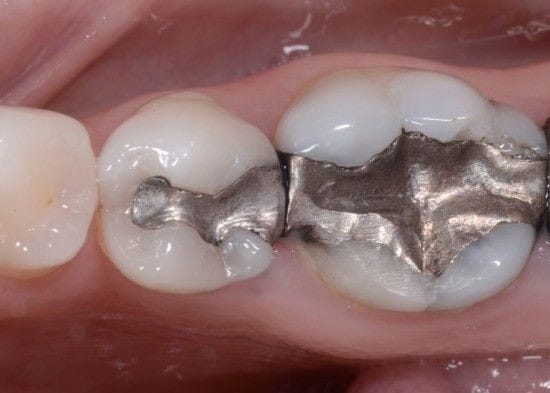What is filling amalgam? How does the composition of amalgam fillings differ from other types of dental fillings?
Filling amalgam was popular in the early 19th century for restoring damaged and decayed teeth, now the use of filling amalgam is limited to the posterior teeth due to its silver colour appearance. It is also known as a silver filling. Filing amalgam is composed of a mixture of metal alloys of silver, zinc, tin, copper and mercury.
In Dental care centre, our expert dental specialist used filling amalgam in high chewing stress in the posterior teeth on which other filling materials do not support due to heavy, repeated chewing such as in parafunctional habit or night grinding that causes wear and fractures in other filling materials. Patients’ aesthetic concerns, and the availability of better tooth-colour filling material restricted the uses of filling amalgam in anterior or front teeth.
Filling amalgam is different from other filling materials in many aspects such as
Composition
Filling amalgam is composed of metals that give it exceptional strength and fracture resistance. During treatment, the powder metal alloy is mixed with liquid mercury to make smooth mixtures and placed in the prepared cavity.
Excellent strength and durability
Filling amalgam is popular for its durability, and remarkable strength and easily supports heavy biting force when placed in posterior teeth or molars. The duality of filling amalgam is three times more than composite or tooth-colour filling.
Appearance
Filing amalgam is also known as silver filling due to its silver-grey appearance and it makes it noticeable when placed in front teeth, as compared to other teeth colour restorative materials such as composite, porcelain and ceramic filling material that naturally blends with adjacent teeth and gives a more natural appearance.
Technique
Filling amalgam is placed with different techniques. Careful cavity preparation is required to provide maximum retention of filing amalgam. After cavity preparation mixture of amalgam is placed in the cavity with proper packing so it is tightly adapted to the tooth cavity. our expert dental specialist at the dental centre skilfully prepares teeth and expertly places filling amalgam in posterior teeth restoration.
Mercury
The mercury content in filling amalgam helps in the setting and adaptation of metal content in the tooth cavity. In filing amalgam minor quantity of mercury vapour is released that may cause harmful effects in multiple amalgam filling. Filling amalgam is not indicated in pregnant and nursing women due to the harmful effects of mercury exposure.
Can amalgam fillings be used to restore teeth with extensive decay or damage, or are they more suitable for minor restorations?
The selection of filling material for tooth restoration depends upon various factors such as patient age, health, oral hygiene conditions, aesthetic preferences, location of tooth and extension of damaged part in restoring tooth. our expert dental specialist takes a complete medical and dental history, carefully examines the dental health of patients and takes radiographs for accurate estimation of cavity extension.
Filling amalgam is used to restore both mild to moderate and extensive damaged teeth. Due to its grey appearance, it is widely used in posterior teeth In mild to moderate such as fractured or chipped tooth parts, filling amalgam provides long-term durable results.
In extensive damage tooth or large cavity filling amalgam is the best choice due to its exceptional strength and fracture resistance in posterior teeth where aesthetics is not the main concern and strength and durability are priorities.
What are the potential risks or complications associated with having amalgam fillings, and how can they be prevented or managed?
Some potential risks are associated with filling amalgam but these can be reduced by taking proper precautionary measures
Mercury exposure
Mercury is the binding component in filling amalgam. A low amount of mercury, within the safe limit, is released when an amalgam filling is placed. Mercury exposure can have harmful effects when placed in multiple teeth for the long term. For safe side filling amalgam is not placed in pregnant women, nursing mothers, children below 15 years old, or patients with neurological impairment and kidney dysfunction.
In the dental care centre, our expert dental specialist follows all the precautionary measures such as taking complete medical history of patients before placement of filing amalgam to avoid any complications. Mercury exposure is an ongoing debate, research proved that the use of filing is completely safe but long-term placement of filling amalgam can cause harmful effects due to mercury vapour.
Allergic reaction
Some patients have metal allergies when filling amalgam is placed in such individuals it causes soft tissue irritation, discomfort, ulceration and inflammation. In filling amalgam nickel and copper components can cause allergic reactions. our expert dental specialist before placement of restoration takes patients’ allergic history in detail and chooses other filling materials to restore the teeth. Patients should inform dental professionals about their pre-existing medical conditions and allergies so they can provide safe and comfortable dental care.
Tooth crack and fracture
Extensive deep cavities or root canal-treated teeth when restored with filling amalgam can cause cracks and fractures in tooth structure due to its contraction or expansion property in a variation of temperature. our expert dental specialist carefully placed filing amalgam to avoid oversized and thin cusp build-up to reduce cracks lines, fractured cusp and split teeth. Our dental specialist regularly monitors the restored tooth for any damage and fracture after placement.
Aesthetic concerned
The silver-grey appearance of the filling amalgam compromises the aesthetics in the visible smile area. It provides durable and long-lasting results in posterior molar but it can be replaced with tooth-coloured filling material due to patient aesthetic concerns.
Conclusion
Filling amalgam is a preferable filling in posterior teeth due to its exceptional strength and durability due to its silver-grey appearance it is not used for front teeth restoration. In the dental care centre, our expert dental specialist restores posterior teeth with filing amalgam in patients with special dental needs by taking all the precautionary measures to avoid complications.
Dental Care Centre, London is one of London’s Leading Clinics. Set over 5 floors and 800m2.it is the largest general, specialist, and cosmetic clinic in London with a team of general dentists, cosmetic dentists, and specialist dentists. From a simple oral health check to the most advanced smile reconstruction Dental Care Centre Leads the way in UK dentistry. Our patients come to us from all over London and the United Kingdom. You can book an appointment 24/7 by visiting https://www.dentalcarecentreuk.co.uk/book-online-now or call us on 020 7639 3323













